by KenBay | Jan 23, 2024
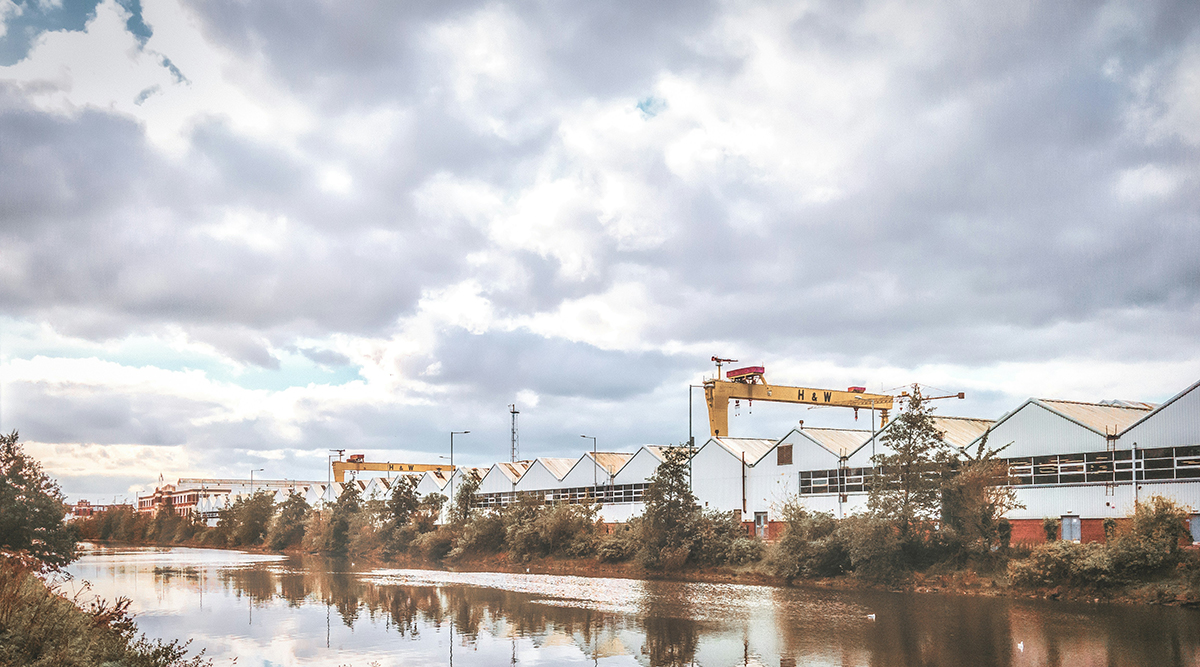
In the dynamic landscape of modern manufacturing, the mantra of “Reduce, Reuse, Recycle” is more than just a catchphrase – it’s a strategic approach that can revolutionize industrial processes. By incorporating these principles, manufacturers not only contribute to environmental sustainability but also stand to significantly reduce costs associated with industrial waste. In this article, we will explore creative ways manufacturers can implement the 3R’s to enhance their practices and make a positive impact on both their bottom line and the planet.
(more…)
by timm | Jan 29, 2018
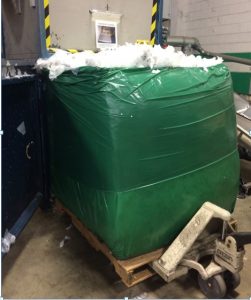 Do you have facility costs that you haven’t factored into your bottom line? Every production facility has waste. It’s unavoidable. But knowing how to adequately reduce its footprint, its hauling cost and potential for possible injuries can make all the difference in the world. If you have cardboard boxes coming into your production area filled with components or supplies and you are still breaking them down by hand, you have room for improvement. Cardboard is recyclable. It’s also messy if not properly dealt with at the point of taking out components. If you’re chasing after savings in your facility by parring down production costs, it might make sense to first examine how you are dealing with excess cardboard.
Do you have facility costs that you haven’t factored into your bottom line? Every production facility has waste. It’s unavoidable. But knowing how to adequately reduce its footprint, its hauling cost and potential for possible injuries can make all the difference in the world. If you have cardboard boxes coming into your production area filled with components or supplies and you are still breaking them down by hand, you have room for improvement. Cardboard is recyclable. It’s also messy if not properly dealt with at the point of taking out components. If you’re chasing after savings in your facility by parring down production costs, it might make sense to first examine how you are dealing with excess cardboard.
It’s Simple…Reduce Costs That Are Adding Up
Does dispersing components/supplies received add to the problem of disposing of the packaging materials in your plant? Some areas may be in foods or medicines processing areas where disposing of the packaging there is not permitted. Many locations that receive components/supplies may not have the space there, especially if it is expected to separate the trash from the packaging that can be recycled. In addition, unpacking on the production line may have an effect upon production.
What You Can Do to Reduce Facility Costs
An effective way to solve these problems may be to consider unpacking components where they are received. This can have a number of the following benefits:
- Save space in the production area
- Reduce the cost of collecting the packaging material
- Make it more cost effective in compacting for disposal of the packaging material
- Reduce traffic of persons and/or forklifts in the plant
KenBay has been providing companies with the ability to package the materials more cost effectively by reducing labor and achieving much higher compaction.
Turn to KenBay for a Better Compactor
There’s a lot of compactor options out there to reduce your facility costs. It may be tempting to think that bigger is better. But buying a large bulky compactor is no guarantee of power. Instead, why not try one of KenBay’s RotoPacs? The RotoPac is portable, so you can transport it easily across the floor to wherever you need. Put it right at the source of your waste for maximum effect. And you can bet that the RotoPac has a fantastic compaction rate! If you want to try out a RotoPac for yourself, visit our website to try one out for yourself. You’ll be impressed at it’s power . . . and your savings!
by timm | Jun 13, 2017
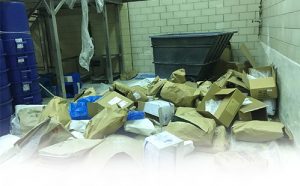 Bakeries, ingredient processing companies, the granary and feed industry, among many other high and medium volume industries receive content in 50 lbs. bags. The bags are generally made of paper lined or reinforced with plastic. Problems these emptied bags create are the following
Bakeries, ingredient processing companies, the granary and feed industry, among many other high and medium volume industries receive content in 50 lbs. bags. The bags are generally made of paper lined or reinforced with plastic. Problems these emptied bags create are the following
- They are made of mixed materials, i.e., plastic and paper make them unfeasible to easily and properly recycle.
- Large volumes of bags require wasted hours of physical labor & forklifts to transport bags to waste compactor, especially to stationary compactors or dumpsters.
- Getting the bags transported and compacted to reduce hauling costs can be somewhat labor intensive.
The factors affecting the disposing of these 50 lbs. bags are that the bags need to be greatly compacted and it is highly desirable that it be done where the bags are emptied.
Compacting Bags Where They are Emptied
- The person handling the bags can throw the empty bags into the compactor located at the waste’s source without moving after emptying its content into a mixer or another machine. He/she will be the last person touching the bags in the disposal process. If a machine is used to open and empty the bags it can deposit the bags directly into the compactor. The compacting process is best accomplished with the use of a continuous compactor rather than a type of baler.
Dealing with the Dust
- Frequently the residue left in the bags creates a great deal of dust, especially in some instances near where food is being processed. A dust collector can be utilized to remove the dust from the environment from the chute in which the bags are thrown passing to an enclosed chamber compactor. Or dust collection can be done from the enclosed chamber. Compacting 50 lbss. bags into large plastic bags that can be sealed for transport also reduces ambient dust.
Reducing Labor & Hauling Costs:
- Costs are reduced with fewer trips either using a pallet jack or a forklift to remove the waste filled bag from the compactor to the hauler’s container outside. The waste filled bags contain approximately 800 50 lbs. bags. Contrast this to frequent trips hauling between 100 and 200 bags loosely placed on a pallet being hauled by forklift. Reducing forklift traffic on a factory floor is always a good thing in a number of ways, such as, safety, maintenance and cost reduction.
- One meter cubes of plastic filled waste are easily manageable for transporting either in a dumpster to landfill or in a covered trailer with double stacked bags to a Waste to Energy facility. Reducing the cost of transport of waste is critical to profitability in all types of waste disposal whether it be to landfill, recycling or Waste to Energy (WtE) facilities.
KenBay has been helping many companies in a variety of industries reduce labor and hauling costs of those ubiquitous 50 lbs. bags using the original industrial rotary arm compactor, the RotoPac. Why not go to the front page of www.kenbay.com and see the RotoPac in operation? If you would like to try out a KenBay RotoPac for yourself, you can try one before you buy one. Simply pay a small fee and we’ll send one to your location. After all, you have nothing to lose but costs.
by CharlieB | Feb 17, 2017
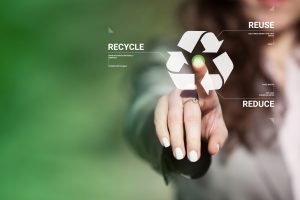 We are almost two months into 2017, and many people have given up on their New Year’s resolutions. Maybe you wanted to be more environmentally minded this year, but that mindset fell by the wayside in favor of other obligations. Is it too late for you to make the changes you wanted so badly last December? Not at all! We here at KenBay believe that the second best time to change your habits is today (the best time was yesterday). If you want to make 2017 your year of change, here’s a great mantra to live by: Reduce, Reuse, Recycle!
We are almost two months into 2017, and many people have given up on their New Year’s resolutions. Maybe you wanted to be more environmentally minded this year, but that mindset fell by the wayside in favor of other obligations. Is it too late for you to make the changes you wanted so badly last December? Not at all! We here at KenBay believe that the second best time to change your habits is today (the best time was yesterday). If you want to make 2017 your year of change, here’s a great mantra to live by: Reduce, Reuse, Recycle!
Reduce
If you want to make an environmental difference at your plant, reducing waste should be one of your first priorities. How do you know the amount of waste you’re generating? A great first step is to examine your material flow. Look at what’s coming into your plant, how it is used, and how it leaves. Once you’ve identified the source of your waste, then you can take steps to reduce it!
Reuse
One great way to help reduce your waste is to reuse it! This can look like a lot of different things. Perhaps you can find alternative uses for the giant plastic bags your products come in. Or perhaps you can repurpose scrap metal instead of leaving it around (which, by the way, is a big safety hazard!) And remember, reusing materials doesn’t have to mean physical materials like plastic and metal. Resources like water and energy can also be reused. You can conserve on multiple levels!
Recycle
The last step in our Reduce, Reuse, Recycle mantra is recycling. Interestingly, this is probably the first thing you thought of. And why not? Everyone knows about recycling. Improved environmental education has taught our children the benefits of recycling from a young age. But what is important to keep in mind is that before we can recycle, we must first reduce our waste and reuse what we can. How can we recycle? It’s actually easy — stop sending your waste into landfills! Landfills generate greenhouse gasses and can secrete chemicals into the earth.
Instead, send the waste you can’t reuse to a proper recycling facility. Additionally, look into whether waste-to-energy is a viable option. Waste-to-energy is an excellent alternative to traditional fossil fuels. You’ll reduce your waste and help our energy problem at the same time. It’s like an environmental double whammy!
Remember the mantra: Reduce, Reuse, Recycle. It’s not to late to make these changes for 2017. One thing that can help you reduce waste more effectively? Utilizing the right kind of compactor. A KenBay RotoPac is portable, which means it can be stored at the source of the waste. Say goodbye to enormous compactors that take up half the room! Because our RotoPacs have a constantly rotating arm, your waste is continually pressed and tightened into a convenient cube shape. Cubes are great for stacking and hauling over to the recycling facility! If you are interested in purchasing a KenBay RotoPac for yourself, you can try it before you buy it. If you enjoy the RotoPac, you can even pay to keep the one we send you. Change is possible this year, and KenBay can help.
by CharlieB | Dec 10, 2016
One of KenBay’s mission statements is to operate with zer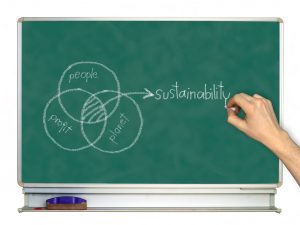 o waste and encourage others to follow suit. Zero Waste means that our company is committed to reusing and recycling our resources and will not send any waste into a landfill. We partner with other organizations who share the same philosophy — and there are many of us out there! We also work to educate others on the responsibilities of being an environmentally conscious company through efforts like this blog! So if you’ve ever wondered about how or why you need to consider the environment more in your processes, keep reading.
o waste and encourage others to follow suit. Zero Waste means that our company is committed to reusing and recycling our resources and will not send any waste into a landfill. We partner with other organizations who share the same philosophy — and there are many of us out there! We also work to educate others on the responsibilities of being an environmentally conscious company through efforts like this blog! So if you’ve ever wondered about how or why you need to consider the environment more in your processes, keep reading.
Zero Waste: The Positives
First, I want you to understand exactly what you have to gain by switching to environmentally conscious practices. Altering your wasteful processes reduces costs, attracts new environmentally conscious customers, and improves your organization’s sustainability. This article from the Queensland government website in Australia does a great job breaking down how these benefits come about. Also, if you think about it, you are unlikely to lose any customers specifically because of your environmentally conscious practices. So, with the opportunity to help the Earth and lots of great benefits for you, is there really a reason not to go green?
How to Get Started?
If you agree that sustainable practices are the right way to go, you may be confused about where to begin. Like other new practices, the internet is both your greatest tool and biggest frustration. In this digital age, you can find whatever information you need right in your own living room. An entire wealth of information is more easily accessible now than at any other time in human history. Fantastic! On the other hand, the internet is overly saturated with information everywhere you turn. Which is the correct way to go green? What are the most effective methods? How do you even get started? Ultimately, you need to thing of your company first and choose what is best for its needs. However, we can tell you that a great resource to turn to would be a company who is committed to an environmentally conscious philosophy. A company that has extensive experience putting that philosophy into practice.
Hey, wait a minute!
Tips from KenBay
Imagine that you are playing a board game and you begin with five points. You must keep all five points in order to be a fully environmentally conscious company. Obviously, points are subtracted for dumping waste in a landfall or a pond, but there are other more subtle ways to lose them as well. If you are trusting (without verifying) another company will sort your waste for recycling, you lose a point. If you aren’t recycling items because there is is product inside the plastic, you lose a point. If you steer away from super sacks because you don’t know how to deal with the empty sacks, you lose a point. You get the picture.
You keep points by keeping track of your product and all the items which make it up, from the minute they enter your factory to the moment they are recycled. One great way to help be environmentally conscious is to use compactors with KenBay. KenBay provides portable compactors that leave a small footprint at the site of your waste. You can compact your waste into small, easy to transport cubes to send off to the recycling center. If you want to experience the KenBay difference, you can try one of our compactors before you buy it. If you like the compactor we send you, you can just pay for it and keep it for good! You can be an environmentally conscious — and KenBay can help!
by CharlieB | Nov 27, 2016
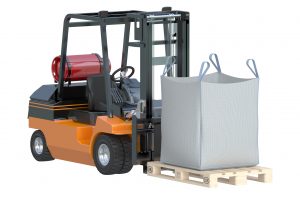 Super Sacks are a truly remarkable invention. Made from a woven polypropylene fabric, these bags are incredibly durable and can handle large storage loads. Given that, they are of course a natural fit for those industries requiring heavy lifting and transportation of goods! Industries like manufacturing, environmental cleanup, and warehouse storage. There are a lot of great benefits to using these bags, but there are some difficulties as well. One of those difficulties is how to handle disposing of them. KenBay is committed to proper disposal of waste, but we also believe in taking advantage of great opportunities. And any chance to make your job easier and more efficient definitely qualifies as a great opportunity. So how can you use the Super Sacks without creating Super Trash?
Super Sacks are a truly remarkable invention. Made from a woven polypropylene fabric, these bags are incredibly durable and can handle large storage loads. Given that, they are of course a natural fit for those industries requiring heavy lifting and transportation of goods! Industries like manufacturing, environmental cleanup, and warehouse storage. There are a lot of great benefits to using these bags, but there are some difficulties as well. One of those difficulties is how to handle disposing of them. KenBay is committed to proper disposal of waste, but we also believe in taking advantage of great opportunities. And any chance to make your job easier and more efficient definitely qualifies as a great opportunity. So how can you use the Super Sacks without creating Super Trash?
Reuse and Recycle
The size and durability of these Super Sacks are like a double-edged sword. On the one hand, they’re so large and hardy that you can use them multiple times! Reusing the bag is a definite must if you want to reduce your overall waste. Between uses, make sure to inspect the bags for signs of wear and tear. Remember: Super Sacks can hold over 4000 lbs, and you definitely do not want that spilling all over your floor! Cleaning out the bags between uses is also a good idea. This helps to ensure there’s no accidental contamination.
Eventually, however, you’re going to reach a point where the sack is less Super and more Sad. That is to say, it’s fairly unusable. Do you need to haul it to the dump? Actually, no! Super Sacks are actually very easy to recycle. That’s great! You get all the benefits of using the sack and you don’t even need to worry about leaving behind a big footprint. Problem solved? Unfortunately, not quite.
The truth is, the bag is flexible, but not nearly to the same degree as a regular plastic or paper sack. The nylon material is rigid enough that it’s actually quite difficult to compact. For some this might not be a major issue. Others, however, might be concerned about financial costs. If you can’t compact the bags then you have to transport them in their original shape, which takes up more space. Or, to be more precise, the air takes up more space. You’ll be paying to transport air instead of stuff, which is wasting your money. So, is there a better way?
KenBay has Your Solution for Super Sacks!
All right, you probably saw this coming. KenBay’s RotoPacs are the perfect solution for compacting Super Sacks for recycling. Our RotoPacs are tough and a constantly rotating arm presses the material into square shapes. These squares are actually great for stacking, which means you’re not paying to haul the air! Now, you can enjoy all the benefits of using Super Sacks without worrying about the disposal. If you are interested in using KenBay’s RotoPacs for Super Sacks or your other waste disposal needs, you don’t need to wait! You can try it before you buy it. See if our RotoPacs are right for you — and most find they usually are!
by LaurenL | Oct 13, 2016
 For many businesses, a common barrier to recycling is a lack of resources. For businesses that handle recyclable cans, PET bottles, or cartons, depackaging equipment can help. While there are depackaging companies that can handle this task for you, many businesses now opt to complete the simple process themselves. Typically, these types of containers are not recycled because, in order to do so, they must first be rinsed of their liquid waste. A depackaging machine can do this task for you, while also benefiting your recycling efforts in other surprising ways. Here’s how.
For many businesses, a common barrier to recycling is a lack of resources. For businesses that handle recyclable cans, PET bottles, or cartons, depackaging equipment can help. While there are depackaging companies that can handle this task for you, many businesses now opt to complete the simple process themselves. Typically, these types of containers are not recycled because, in order to do so, they must first be rinsed of their liquid waste. A depackaging machine can do this task for you, while also benefiting your recycling efforts in other surprising ways. Here’s how.
1. No Pre-Cleaning Required
Depackaging is an integral part of waste management processes for zero waste businesses in the food industry. Thanks to this technology, they can easily separate recyclable containers from the food waste that may be inside. Food depackaging equipment varies, but popular models either unscrew bottles, or perforate cans, cartons, and bottles and then rinse whatever liquid is contained inside. This is particularly good for depackaging milk, yogurt, soft drinks, BBQ sauces and ketchup, ice cream, liquid soaps and detergents, and more.
Often, precleaning keeps people from recycling. However, with the right depackaging equipment, you can simply throw full containers into the machine. These containers are perforated or unscrewed by the machine. Then, the depackaging equipment works its magic. Food waste and other liquids inside containers are removed.
2. Recyclable Material is More Easily Managed
Not only does depackaging save you time that would otherwise be devoted to emptying containers of their waste, it can also save you money in your pursuit of zero waste. The best depackaging systems also have compaction chambers. After your containers are perforated and emptied, they are shredded or compressed tightly. With depackaging equipment that also has a high compaction rate, you’ll be able to load more recyclable waste on a single truck and make fewer trips to recycling centers or Waste to Energy plants. Because of this, you’ll spend less money on managing your recyclable waste.
3. Non-recyclable Items Can Be Repurposed
A little-known fact: depackaging equipment can also help businesses manage non-recyclable items like styrofoam or other similar materials. If your business is often left with EPS Polystyrene fish boxes and packaging, EPS dust, polypropylene packaging and insulation foam, or polypropylene (EPP) packaging, depackaging equipment can help you manage this waste. Like recyclables, these items can be emptied of any waste they may hold.Then, the foam that is left over can be condensed to create large blocks of foam. These blocks can then be sold, creating a new revenue stream for your business.
Integrate Depackaging Into Your Waste Management Process with KenBay!
If you think your waste management process could benefit from depackaging, let KenBay help you find the perfect equipment to get the job done. Our SC 2000 and SC 3000 Screw Compactors are configured for depackaging, dewatering or foam densifying. If you want to make your facility landfill free, these screw compactors can be an integral part of your waste management system. Low maintenance and heavy-duty, a KenBay screw compactor is capable of handling large throughputs of material while still maintaining a high compaction rate continuously throughout the operation.
We know that waste management can be a burden. But, with KenBay, you’ll have the tools you need to help make the job a little easier. The next time you evaluate your waste products and waste management strategy, consider integrating one of our industrial trash compactors into your processes.
Because our depackaging trash compactors will reduce the weight and size of your recyclable waste, they are a great way to cut down your waste removal costs and improve the efficiency of waste management.
Don’t let something like waste get in the way of your business operations. If you’re interested in learning more about depackaging or finding a committed consultant to help you reduce your waste, call KenBay. We can tell you more about our services, no matter what industry you’re in, or how much waste you are creating!
Photo credit: Getty Images / photka
by charlotte | Aug 17, 2016

If you are producing multiple tons of waste a week, logistics costs can start to pile up quickly. Landfills are filling up and many of them are even closing, leading to even higher logistics costs associated with waste because companies are left to ship it farther distances. When you are already paying for other streams of shipping throughout your business processes, it makes sense to spend less on your waste than you do, say, on shipping products to your customers. If you have yet to consider how much you are actually paying in logistics costs when it comes to waste management, it’s time to crunch some numbers and get those costs down.
Waste Management
When it comes to lowering company-wide logistics costs, waste management is a great place to start. Many new business owners don’t consider that waste management is a thing to take seriously until they get that first waste removal bill. There are various streams of waste to consider when doing a waste management audit, and not just those associated with trash. You can also consider other areas of sustainability like energy and water use. Are there other valuable resources that are not being monitored and therefore producing waste besides the actual materials you are sending to the landfill?
Reduce, Reuse, Recycle
Corporate responsibility necessitates that you manage your waste wisely by recycling and disposing of things like hazardous waste properly. There are many ways to reduce waste coming from your facility, and they all start with a proper audit of all your processes and the waste they produce. By auditing your waste consistently for a designated period you will discover where there are unnecessary or avoidable waste streams and can figure out where to move from there to reduce them. One waste stream you can almost always reduce is packaging. Consider your purchasing practices and how you might order things in a way that cuts down on packaging waste. Packaging can come in many forms from cardboard to shrink wrap and ends up as both trash and recycling.
Furthermore, there are many things that are determined waste that can be useful as opposed to discarded. Things like manilla envelopes and plastic containers can be easily stored for second use. There are also many options to sell used goods to other companies who can use or recycle them, creating a passive income stream where you would have been dishing out in logistics costs.
Invest in a Commercial Trash Compactor
Are you looking to improve the sustainability of your business, as well as the safety of your workplace? Commercial trash compactors are the absolute best bet for achieving both of these goals. With many different sizes and specialities, there are commercial trash compactors for every purpose waiting to prove their return on investment. Not only can you improve the sustainability of your own company, but a commercial trash compactor will help you reduce the volume of waste that you are sending to your local landfill.
For more information about how the manage your waste in such a way that you will reduce logistics costs throughout your company, call KenBay.
by charlotte | Jun 16, 2016
 Are you looking to start or improve upon a zero landfill initiative to do your part for the conservation of our beautiful world? You’re in luck because at KenBay we are experts in helping companies achieve their zero landfill initiative goals and have all the tools you need to see it through. A zero landfill initiative does more than simply divert waste from the landfill, it will actually end up saving your company money on waste transportation, as well as improve the overall safety in your manufacturing facility.
Are you looking to start or improve upon a zero landfill initiative to do your part for the conservation of our beautiful world? You’re in luck because at KenBay we are experts in helping companies achieve their zero landfill initiative goals and have all the tools you need to see it through. A zero landfill initiative does more than simply divert waste from the landfill, it will actually end up saving your company money on waste transportation, as well as improve the overall safety in your manufacturing facility.
What is a Zero Landfill Initiative?
As opposed to a zero waste initiative, which constitutes absolutely no waste or recycling, a zero landfill initiative is defined by diverting the majority of waste from the landfill in favor of producing only recyclable waste. There are three degrees of landfill initiatives to strive for, the most ambitious of which is the zero landfill initiative which constitutes that 100 percent of waste is diverted from the landfill. Then there is the virtually zero landfill initiative with diversion rates of 98 percent or higher. Finally the landfill waste diversion initiative is for companies aiming to divert at least 80 percent of their waste from the landfill. Figure out which goal is the most attainable for your company and begin taking steps towards achieving it! Reducing your landfill waste is often a process that will improve over several years so don’t try to fix it all in one month and then never think about it again. It’s a long term commitment!
5 Ways to Make Progress on Your Zero Landfill Initiative
- Work With a Waste Management Company
Waste management companies like KenBay are experts in helping organizations of all kinds reduce their waste. We can help you do everything from company-wide waste audits to find more efficient and safer production practices, as well as provide new equipment that will help you reduce the volume of your waste.
- Perform Consistent Waste Audits
There is no way of knowing how to reduce your waste if you don’t know where it’s coming from and what kind of waste it is. You need to track your waste throughout every aspect of your business in order to make a targeted plan to both reduce and eliminate certain waste streams.
- Think Both Short and Long Term
The necessity of having both a short and long term plan for achieving your zero landfill initiative is absolutely crucial to seeing results. You won’t be able to make huge amounts of progress right away, so make sure you have actionable small goals through which you can measure progress to keep yourself and the rest of the company motivated towards the long term goals. Honda has been working towards their zero landfill initiative for over a decade!
- Buy a Trash Compactor
Trash compactors have the ability to reduce your waste volume at a rate of six to one meaning that, if you are still producing landfill waste, you can significantly reduce the space it will take up in the landfill as well as your own hauling costs. The same trash compactors can also be used for recycling, achieving the same ends for recycling centers.
- Use Biodegradable Bags
A great way to work towards your zero landfill initiative is to use biodegradable bags that will disintegrate over time, leaving one less plastic bag in the recycling center or landfill. This is a small and easy measure to take towards achieving your goals.
A zero landfill initiative is a worthwhile goal for your organization, no matter what industry you are in. If you want to know more about how a waste management company can help you achieve a zero landfill initiative, give KenBay a call!
by charlotte | Jun 10, 2016
 Waste removal is something business owners don’t often consider since they aren’t responsible for doing it. Oftentimes when paying for a service, especially from the city, it’s easy to forget that, and the end of the day, we have a stake both financially and in terms of safety in our waste removal. By seeking ways to reduce waste you will necessarily find ways to improve safety in your workplace, as well as save money not only in removal, but also in countless other ways you may not even realize are opportunities.
Waste removal is something business owners don’t often consider since they aren’t responsible for doing it. Oftentimes when paying for a service, especially from the city, it’s easy to forget that, and the end of the day, we have a stake both financially and in terms of safety in our waste removal. By seeking ways to reduce waste you will necessarily find ways to improve safety in your workplace, as well as save money not only in removal, but also in countless other ways you may not even realize are opportunities.
Start With a Waste Removal Audit
Whether you’re doing it in-house or working with a company like KenBay to perform a waste removal audit, this is the first step in finding ways to improve safety and reduce waste removal costs. Commit to assessing every part of your processes and operations that produce waste and consider how you might be able to cut back on waste in those circumstances. There are often things that can be recycled that are going into the waste can. Another common oversight is the opportunity to reuse things yourself, or find someone in your community who would consider something that is waste to you a valuable resource for them. Turn to your community to find partnerships like this and you just may save money in buying things you could get at discounted prices, on trade, or completely free
A waste removal audit will also give you an opportunity to take a good hard look at how much waste you are actually producing over all. What does your huge trash bin look like at the end of the week? Is it overflowing, or could it go another week without being picked up. Find solutions either way that will help you reduce waste removal costs. Trash compactors are always a great option, whether you’re on one extreme or the other, allowing you to reduce the size of your waste, and therefore the costs associated with removing it.
The Overflow of Audits
The nice thing about performing a waste removal audit is that you will look at waste collection and removal as a whole system throughout your business. You will start to consider how you can streamline this process that before may not have seemed a significant part of anything at all. When you start to reason about where your waste cans are placed, and whether they are in the most strategic and best places, the safety and cleanliness of your workplace will undoubtedly improve. Trash compactors are a helpful addition, allowing you to ensure that your waste is never unruly and unconfined. Waste cans are overlooked hazards by either being constantly overflowing, or placed too close to vents and heat sources. The safety of your employees will increase while your liability decreases when you start to consider your waste removal.
You will never know if there are improvements that can be made if you don’t take that first step in performing a waste removal audit. Get started and don’t hesitate to call in the KenBay troops for some expert advice and help in approving upon your waste removal practices.



 Do you have facility costs that you haven’t factored into your bottom line? Every production facility has waste. It’s unavoidable. But knowing how to adequately reduce its footprint, its hauling cost and potential for possible injuries can make all the difference in the world. If you have cardboard boxes coming into your production area filled with components or supplies and you are still breaking them down by hand, you have room for improvement. Cardboard is recyclable. It’s also messy if not properly dealt with at the point of taking out components. If you’re chasing after savings in your facility by parring down production costs, it might make sense to first examine how you are dealing with excess cardboard.
Do you have facility costs that you haven’t factored into your bottom line? Every production facility has waste. It’s unavoidable. But knowing how to adequately reduce its footprint, its hauling cost and potential for possible injuries can make all the difference in the world. If you have cardboard boxes coming into your production area filled with components or supplies and you are still breaking them down by hand, you have room for improvement. Cardboard is recyclable. It’s also messy if not properly dealt with at the point of taking out components. If you’re chasing after savings in your facility by parring down production costs, it might make sense to first examine how you are dealing with excess cardboard. Bakeries, ingredient processing companies, the granary and feed industry, among many other high and medium volume industries receive content in 50 lbs. bags. The bags are generally made of paper lined or reinforced with
Bakeries, ingredient processing companies, the granary and feed industry, among many other high and medium volume industries receive content in 50 lbs. bags. The bags are generally made of paper lined or reinforced with  We are almost two months into 2017, and many people have given up on their New Year’s resolutions. Maybe you wanted to be more environmentally minded this year, but that mindset fell by the wayside in favor of other obligations. Is it too late for you to make the changes you wanted so badly last December? Not at all! We here at
We are almost two months into 2017, and many people have given up on their New Year’s resolutions. Maybe you wanted to be more environmentally minded this year, but that mindset fell by the wayside in favor of other obligations. Is it too late for you to make the changes you wanted so badly last December? Not at all! We here at  o waste and encourage others to follow suit.
o waste and encourage others to follow suit.  Super Sacks are a truly remarkable invention. Made from a
Super Sacks are a truly remarkable invention. Made from a 

 Are you looking to start or improve upon a zero landfill initiative to do your part for the conservation of our beautiful world? You’re in luck because at KenBay we are experts in helping companies achieve their
Are you looking to start or improve upon a zero landfill initiative to do your part for the conservation of our beautiful world? You’re in luck because at KenBay we are experts in helping companies achieve their  Waste removal
Waste removal